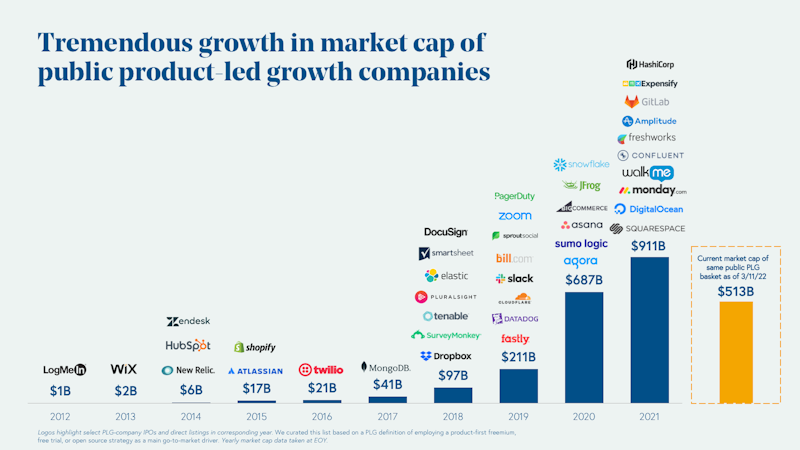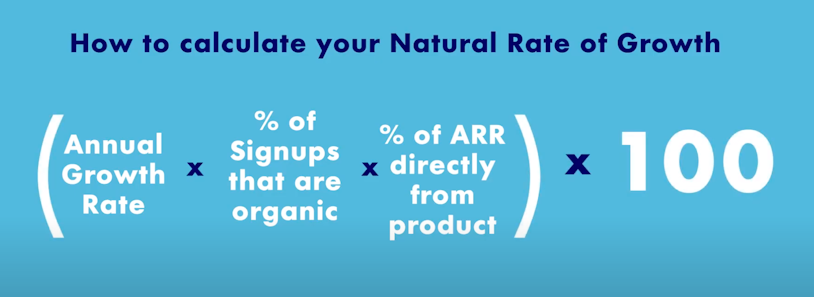We’re in the midst of a seismic shift in how we purchase software. Since software joined the cloud, the number of product-led growth companies has skyrocketed. And with good reason. Customers no longer want sales pitches, they want to test-drive products. In fact, a Forrester report in 2015 indicated that almost 75% of B2B buyers prefer to purchase through an app or website than a salesperson.
Product-led growth lets the product do the talking. As such, companies that adopt this approach tend to scale faster. Put simply, the less emphasis on sales and marketing, the lower the customer acquisition cost.
Take Zoom.
Zoom burst onto the scene in 2011 in an already crowded market. With competitors such as Cisco and Microsoft, it seemed like an unlikely success story. However, Zoom was born as a result of CEO Eric Yuan’s own frustrations with the video conferencing software on the market. The product showed its value straight out of the gate with a seamless entry point that offered free calls for up to 40 minutes.
Cut to 2021 and Zoom earned over $882 million in the final quarter of the fiscal year. The moral of the story? Even the toughest markets can be broken into (and dominated) when the product is leading the charge.
In this guide, we break down the whats, hows, and whys of product-led growth.
What is Product-led Growth (PLG)?
Product-led growth (PLG) is a product-centric business model. With PLG, the product is the main driver of user acquisition, conversion, development, and customer retention.
PLG breeds democracy. Since the product is the main source of business growth, all teams are aligned with the common goal of building better products. PLG companies are categorized by a democratic decision-making process, opening the floor to a more diverse set of stakeholders. While this may make the decision-making process slower and more complex, it ultimately leads to better results.
A word of caution, though. Given that the product does the sales and growth marketing, an outstanding user experience is essential. That’s why you need your product to communicate value just as clearly as a salesperson or marketer would. In short, if your product is going to do the talking, it needs to have a clear voice.
At Adam Fard, we’re big believers in showing rather than telling. So here are a couple of examples of PLG companies that are doing it right.
Slack
Slack has gained a huge following since it went public in 2013. The main driver behind its stellar growth is simple; a really great product. Starting from there, Slack built its brand around the product, blurring the lines of functionality and fun. Thanks to its PLG mindset, 43% of Fortune 100 companies are Slack customers.
Calendly
Calendly is a scheduling tool that makes it easy to set meetings across different time zones. With a frictionless entry point and a product that solves a common issue, Calendly has become a poster child for PLG. Calendly now has 10 million active users, the VP of Product and Design explains why below:
“There may be all kinds of complex strategies and tactics rolled up under PLG: good product-market fit, viral loops, and more; but at the end of the day it all boils down to one simple core idea: Solve your customer’s problems.”
–Oji Udezue, VP of Product and Design at Calendly
And these two PLG giants are just the tip of the iceberg. Product-led growth companies are everywhere. So, let’s look at what they have in common.
The common denominator in PLG companies is a bottom-up approach. Businesses that use a product-led growth model offer barrier-free entry with a freemium or a free trial. In doing so, their marketing strategy focuses on getting people to try the product, rather than pushing them into the arms of an eager salesperson.
That’s just half the battle, though. Once users are on board, brands must find a way to convert them into paying customers. This is done through a series of steps, starting with an excellent onboarding experience and followed up by seamlessly embedding sales and marketing messages into the product.
As the number of large enterprises with a PLG model continues to grow, 91% of companies plan to increase their investment in PLG strategy in 2022. This is hardly surprising considering that PLG companies outperform their competitors, grow faster at scale, and boast higher enterprise value (EV).

A Brief History of Growth Methodologies
Product-led growth makes more sense when viewed in opposition to marketing- and sales-led growth. So, let’s take a quick trip down memory lane.
The eighties and nineties.
Sales-led growth was the growth approach of choice in the eighties and nineties. This period was characterized by on-premise data centers and, consequently, trouble accommodating new software to the existing solutions. With this model, software developers prioritize convincing buyers (the decision-makers) as opposed to end-users. As the name suggests, salespeople are the primary source of revenue in a sales-led growth approach.
The early 2000s.
The 2000s saw a rise in a marketing-growth model. Prompted by the launch of companies like Salesforce, this methodology appeals to customers’ needs and communicates its value on a wider scale. As such, marketing campaigns became the main way to generate leads. While this model focuses more on customers’ needs, it still prioritizes buyers over end-users. The buying decision remains in the hands of executives and is driven by KPIs and ROIs.
2016 and beyond.
Since the term ‘product-led growth’ was coined back in 2016, it has become one of the most influential trends in the software industry. With the advent of API, cloud, and software compatibility, developers aren’t required to hard-code each program from zero anymore. As a result, infrastructure is more scalable, accessible, and affordable than ever. Thanks to huge strides in accessibility and affordability, users can try new products with just a click of their mouse.
In this era, end-users reign supreme. So, the question is no longer how the product will affect the ROI, but rather how it will enhance users’ day-to-day lives. In a nutshell, PLG symbolizes a shift in who is making the purchasing decision. Where once the decision was made by a buyer (executive) based on business metrics and infrastructure compatibility, it’s now in the hands of end-users focused on product value and functionality.
Principles of Product-led growth
Let’s get down to the nitty-gritty. Like most business methodologies, product-led growth is based on three main pillars. We’ve summed each principle up below.
Focus on the end-user
As a team of UX designers, we may be a little biased. But, we couldn’t be happier about the birth of a growth model that’s impeccably consistent with the principles of user experience. Unlike previous growth models, the product-led approach is bottom-up (prioritizing the needs of end-users, as opposed to those who make the purchasing decision). On top of that, this approach helps tackle real-world problems without any physical or proverbial middlemen.
In short, this approach encourages designing for real people, not ROIs. As Calendly’s CEO and Founder put it:
“Designing for end-users is really understanding what they do—and it’s also truly understanding who you serve.”
–Tope Awotona, CEO and Founder at Calendly
Delivering Value as Fast as Possible
Since we’re zeroing in on product as opposed to sales & marketing, we need to show value and elicit an “aha moment” very quickly. Failure to do so will risk losing interested potential consumers. Essentially, you must remove barriers, such as pay-walls and long sign-ups, for prospective customers. What’s more, you need to streamline and personalize your onboarding in a way that tackles all the problems the user came to your product to solve.
In a nutshell, PLG companies focus on keeping time to value (TTV) as short as possible. In doing so, users almost immediately recognize the value of your offering. The best way to showcase your product value is by giving access to the product, removing barriers, and quickly solving their problem.
“Growth starts with a deep understanding of product value and is about moving new users to the Aha! moment as quickly as possible, measurable in seconds.”
–Chamath Palihapitiya, CEO of Social Capital Led Growth at Facebook from 2007-2011
Become growth-driven
Let’s look at the process behind creating software. While the initial costs of building software tend to be higher than those required to deliver a professional service, they become dramatically less as you acquire customers. Therefore, when bringing a product to market, PLG companies focus on building a product that will drive user acquisition, conversion, and market growth.
Growth-driven companies tend to do the following:
Encourage experimentation as a tool to drive growth and improvements to the user journey.
Set up a rigorous system that analyzes product data, using it to inform decisions and track progress.
Create shared team ownership over promoting product-driven expansion, virality, essential metrics, and so on.
Growth-driven companies also try to find leads from multiple sources, be it from social media, their website, or off the internet. While their approach is targeted (aka, they keep the same branding on each platform), their reach is large. And if they use a platform that connects them with enriching sales lead data, they’ll have an easier time connecting with targeted prospects.
Product-led Growth Metrics
So, what makes tracking PLG metrics any different from your staple software metrics such as CAC, LTV, and retention rates?
The simple answer is an emphasis on organic product-driven growth. While many metrics may overlap, it is this emphasis that sets product-driven and marketing/sales growth apart.
If you’re still using the metrics conventionally used to measure SaaS businesses, it may be time for a refresh. Many PLG experts agree that the original metrics are simply no longer a good fit with this new go-to-market approach.
In fact, according to Sam Richard, Director of Growth at Openview, it’s time to skip the OG metrics altogether and build a better SaaS playbook. To tackle this issue, Sam suggests using the following metric instead:

Let’s break down each element in this metric.
Annual ARR growth rate:
This is measured by taking your current ARR, subtracting your ARR from the previous year, and dividing by your ARR from last year.
% of organic signups:
Organic signups are those you didn’t pay for. Therefore, any users who converted after coming through free channels such as social media, organic google searches (SEO), or word of mouth are considered organic signups. n order to access this organic search data, generating an SEO analytics report from Octoboard is quick and impactful. It also means that the process of exploring the percentage of organic signups you receive can be carried out with precision, as opposed to involving any rounding, raw intuition or guesswork
You shouldn’t include users that come from paid marketing, events, or ads. To get the percentage, divide the number of organic signups by the total number of signups in the previous quarter.
% of ARR from the product:
This is the amount of revenue generated by those using the product (whether freemium or paid). Effectively, you only want to count users who begin using the product, recognize its value, and then convert to customers. This is measured by comparing timestamps of conversion to timestamps of when a user first experiences the product.
Is a Product-led Growth Model Right for your Business?
Research found that most SaaS companies already have a PLG strategy in place. For the small number of businesses that don’t currently have a PLG plan, they list product complexity and product readiness as the major barriers.
Are you unsure if a product-led growth model is right for your business? Well, look no further. We’ve compiled a list of the key indicators that a PLG model might work for your product.
Your product offers a unique value proposition that can be showcased quickly without the assistance of marketing or sales. This is achieved through designing intuitive products that are easy to use and integrate.
Your end-users have the buying power or the power to influence buying decisions.
The product-market conditions are optimal. This involves low marginal costs per user and a chink in the armor of your competitors’ solutions (i.e their products don’t fully answer users’ needs).
Your product has the potential to become viral or build community even with minimal marketing. To achieve this, your product should incentivize users to invite other users and have a way to monitor user behavior.
If your product meets the requirements listed above, there’s a great chance that a PLG model will work for your business. To further increase your odds of success, your business should focus on delivering real value before the paywall. The lightbulb moment needs to happen way before you ask for users’ credit card details. Think of Calendly. The “aha moment” happens after you schedule your first multi-time zone meeting in a fraction of the usual time.
Final Thoughts
The era of the end-user is upon us. Product-led growth is all about designing for the real people who use the product (end-users) as opposed to executives (buyers). As such, PLG companies create products with growth, value, and users in mind. The end result is a scalable product that listens to its customers and offers quick solutions to the problem they face.





